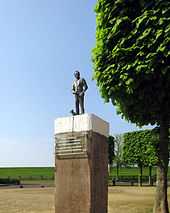Peter Tazelaar
| Peter Tazelaar | |
|---|---|
 Tazelaar (left) with Rie Stokvis and Erik Hazelhoff Roelfzema in Breda on 2 May 1945. | |
| Allegiance |
Netherlands United Kingdom United States |
| Rank | Lieutenant |
| Operation(s) | Contact Holland |
| Award(s) | Military William Order |
|
| |
| Born |
5 May 1920 Fort de Kock, Dutch East Indies |
| Died |
6 June 1993 (aged 73) Hindeloopen, Netherlands |
| Nationality | Dutch |
Peter Tazelaar (5 May 1920 – 6 June 1993) was a member of the Dutch resistance during World War II and an agent for the CIA in the 1950s.[1][2]
Resistance
In September 1938 he trained to be a midshipman at the Royal Netherlands Naval College. In 1939 he moved to Groningen where he enrolled in the Hogere Zeevaartschool. When war broke out on 10 May 1940, Tazelaar was working for the Dutch Merchant Navy. He tried to escape to England by way of Zeeland and northern France, but he failed to reach England. After returning to Groningen in late May 1940, he came into contact with Midshipman John Birnie. During summer 1940, Birnie had joined a group of cadets and midshipmen that had formed a resistance group called the Ordedienst. Birnie introduced his new friend to the Ordedienst which was based in The Hague and headed by Dutch nobleman Joan Schimmelpenninck , who went by the code name of "Uncle Alexander".
Mission to England
Since the resistance had no direct contact with England, Tazelaar was chosen to go to England to make contact with British intelligence forces. In early June 1941 he mustered as a stoker on the Panamanian-flagged, Swiss freighter St-Cergue. The ship was in the port of Schiedam and was voyaging to New York to pick up a supply of corn for the Germans. Two students from Leiden, Bram van der Stok and Erik Hazelhoff Roelfzema, also escaped to England with Tazalaar. In the Faroe Islands they transferred to a British cruiser and were able to reach England.
Contact Holland
At first it was difficult to get into contact with occupied Holland. At one point Tazelaar and his friends communicated with Queen Wilhelmina and her son-in-law Prince Bernhard. They were able to live in the apartment at the home of Wilhelmina in England.
Van der Stok had devised a plan to pick up people in the occupied Netherlands by boat. After arriving in England, Hazelhoff Roelfzema worked out this plan and was instructed by Queen Wilhelmina and the British secret service to execute the plan under the name Contact Holland. The first officer who was put ashore by boat was Peter Tazelaar. On 23 November 1941, he dressed in a tuxedo in Scheveningen in preparation for landing. He pretended to be a drunk reveller and was able to slip past German sentries guarding the beach by the casino. Together with the parachute which had been previously dropped by radio operator Johannes ter Laak, he would establish radio contact with England. Little progress was achieved, however, because the radio was damaged during the drop. Tazelaar's second assignment was the transportation of two important people to England. Again, this did not work, because they proved too difficult to pick up in a boat. Various arrests made it too dangerous for Tazelaar to stay in the Netherlands. At the end of January 1942 he left with midshipman Gerard Dogger via the Van Niftrik escape route to Switzerland. Travelling via France, Spain and Portugal, they arrived in England in April 1942.[3]
Military William Order
After returning to England, Tazelaar was given a training command in Wales. In February 1943 he moved to Canada to be an instructor for the Dutch troops. At the end of 1943 he returned to England. He joined the National Fire Service and married an English woman Dodie Sherston. On 9 September 1944, Tazelaar received the Dutch highest military award, the Military William Order, for his role in Contact Holland. Then he joined the BBO. BBO agents parachuted into occupied Netherlands on sabotage and espionage missions. In November 1944, Tazelaar and Lykele Faber parachuted into Friesland. They provided radio contact with England for six months.
Aide to Queen Wilhelmina
After the liberation of Friesland in April 1945 Tazelaar joined the Dutch headquarters in southern Netherlands. He was appointed adjutant to Queen Wilhelmina. Tazelaar was the one who informed Wilhelmina of the German surrender.[4] A film shot at the time shows him arriving at Gilze-Rijen Air Base with Erik Hazelhoff Roelfzema.
Asia
In August 1945 Tazelaar transferred to Ceylon to participate in the fight against Japan. He served in the same unit as Raymond Westerling. Tazelaar went independently to the Dutch East Indies. His mother lived there in a Japanese internment camp for women and children, Tjideng, in Java. Tazelaar joined the military police and was involved in the detection and interrogation of Indonesian freedom fighters. In March 1946 he was wounded and returned to the Netherlands. That year he married for the second time.
Later life

Tazelaar led an adventurous life after the war, working for the CIA,[2] KLM and Shell. In total, he married four times. He became known to the Dutch public after the release of the book Soldier of Orange and the subsequent 1977 film Soldier of Orange. Tazelaar died on 6 June 1993 at Hindeloopen.
References
| Wikimedia Commons has media related to Peter Tazelaar. |
- ↑ Laurentius, Victor (2009). De grote Tazelaar: ridder en rebel (in Dutch). Den Haag. ISBN 978-90-813972-1-6.
- ↑ 2.0 2.1 Harrison, David (17 April 2010). "The secret war mission that inspired Goldfinger scene". Telegraph. Retrieved 20 January 2012.
- ↑ Hazelhoff Roelfzema, Erik (1972). Soldier of Orange. Hodder & Stoughton. ISBN 978-0340158449.
- ↑ Henri A. van der Zee (1998). The hunger winter: occupied Holland, 1944-1945. University of Nebraska Press. p. 280. ISBN 0-8032-9618-5.